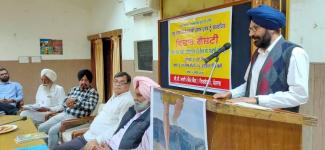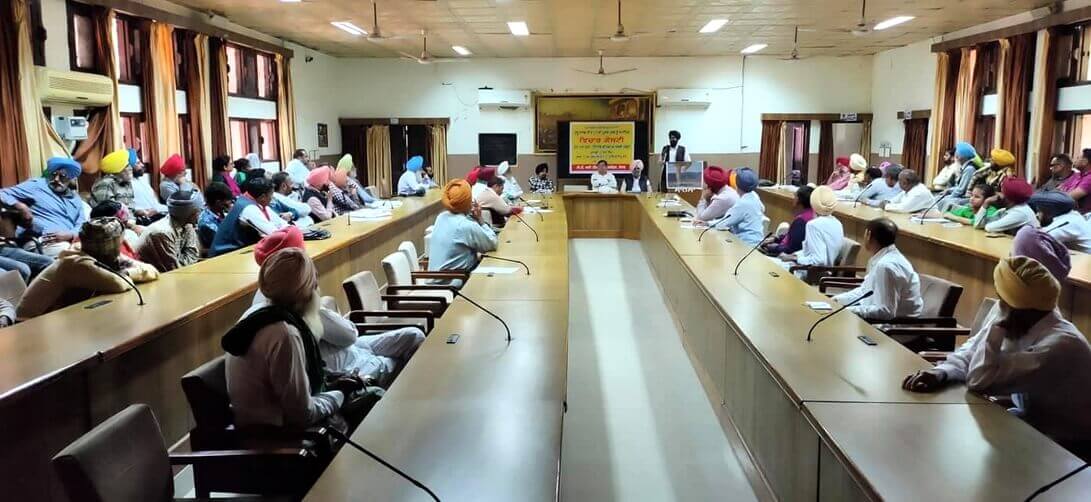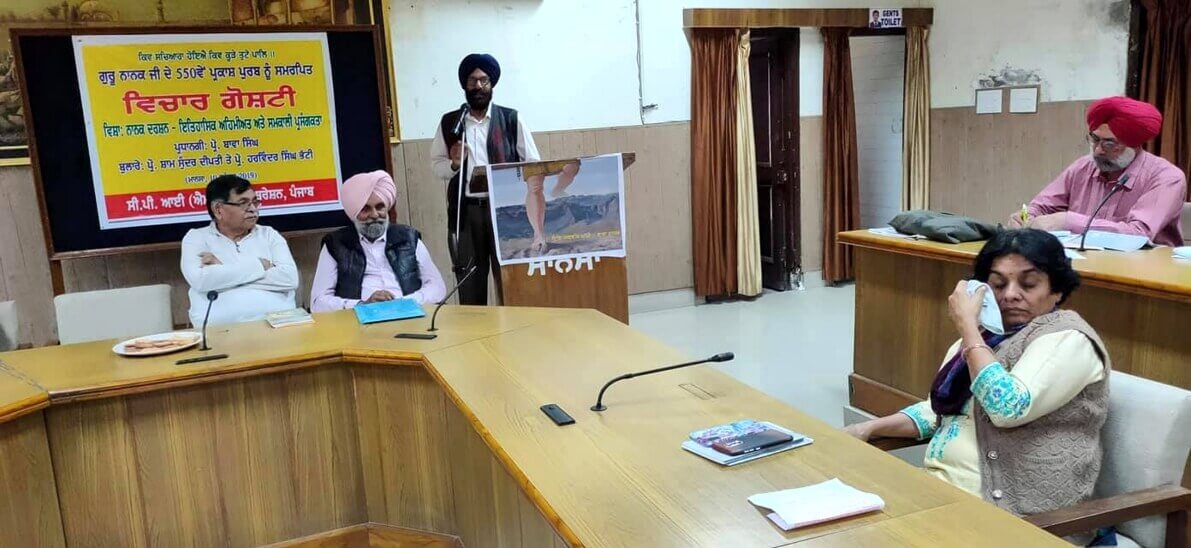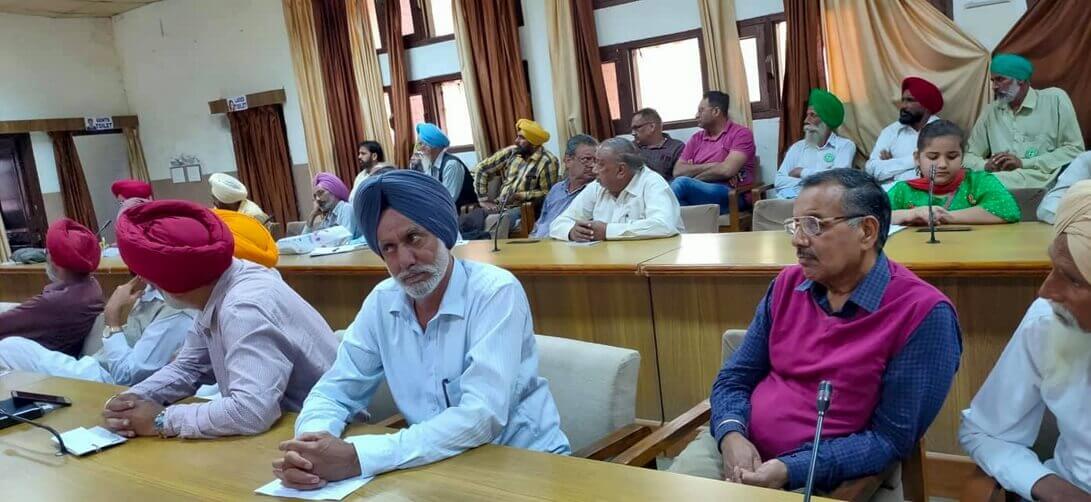
(CPIML organized a symposium on ‘Guru Nanak’s Philosophy: Historical Importance and Contemporary Relevance’ at Mansa in Punjab on 10 November 2019. In this article, Dr Shyam Sunder Deepti, Professor at the Government Medical College Amritsar, the main speaker on that occasion, reflects on Guru Nanak’s relevance in historical and contemporary times.)
We are in the midst of the 550th anniversary year of Guru Nanak’s birth. This is a time when there is a marked crisis for scientific temper – I.e for a life without superstitions and irrational, cruel customs and hierarchies. In his time, such customs, atrocities and social tyranny had moved Guru Nanak to devote his life to fighting them.
Guru Nanak’s life has three phases. The first phase of his life lasted till his decision to work to change society. He observed that society was riven by narrow religious and caste divisions. Untouchability and hatred prevailed. Both Hindus and Muslims practiced intolerance, fanaticism, and hollow ritualism. He understood that the all-powerful rulers patronised the major faiths, temples and mosques, and used them to keep in place an inhumane, cruel and exploitative system.
Guru Nanak, during the second phase of his life which began at the age of 30, went in search of “Gian” – knowledge. He widely travelled to all kinds of places of workship. He travelled about twenty five thousand miles, covering what would today be India, Pakistan, Afghanistan, Bangladesh, Iraq, Iran, Sri Lanka, and Arab countries.

Guru Nanak’s age is also known as the Bhakti Period of medieval India, when saints like Kabir, Guru Ravidass, Namdev, Baba Farid, all raised their voices against the inequalities of the caste system and urged a rational and humane philosophy. Many of these saints themselves hailed from oppressed castes.
Guru Nanak himself belonged to dominant Khatri caste. He was accompanied everywhere by Bhai Mardana, a man born in a Muslim, oppressed caste household. About Nanak, it was said, “Nicha andari nichi jati nichi hu ati nichu. Nnak tinke sanghi sathi, vadia sio kia ris” (he is the lowest among the lowly, he is their companion and had nothing to do with the so called rich elders.) He stood with Bhai Lalo and not with Malik Bhago, and “Jo Rat Pive Manas” (those who suck the blood of the poor).
In the third phase of Guru Nanak’s life, he settled in Kartarpur (now in Pakistan), to which the Pakistan Government has just opened the Langha (corridor to reach the Gurudwara). It was at Kartarpur that Guru Nanak assimilated what he had learned from his travels, and preached his own unique teachings.
His way of preaching to people was “Goshti” - i.e. meeting, discoursing. He claimed that truth is discovered by a conscious dialogue with the enlightened Sidhas. In his process of discourse, he told his followers - “Kuch suniye, kuch kahiye” (first listen carefully then speak consciously) and “Rosh na kije, uttar dije” (Do not get angry, reply patiently).

The main themes of Guru Nanak’s teachings are Kirat, Kudrat and Gian i.e. manual work, respect for nature, and knowledge. All of these aspects are interwoven. Though Guru Nanak was seen as a mystic, he didn’t believe in or prach withdrawal from life and the world. He was against the practices of yogis and sidhas, who withdrew from real life. He was a keen observer and took deep interest in social, cultural and religious problems that the people of that time were facing. His hymns oppose casteism and exploitation, and preach t equality, brotherhood, truthful living, social responsibilities and social justice.
His second main concern, along with active manual work (Kirat) in society, was respect for nature. He recognized that all creatures are part and parcel of Nature, and are dependent upon each other. So he said, “Pavan Guru, Pani Pita, Mata Dharat Mahat” (Air is a great teacher, water is like father and Earth is our beloved mother). Water is so essential that we can’t think to live without it (“Pehal Pani Jio Hai”).
Guru Nanak’s travels (called Udasian) were a quest for knowledge, through posing questions and seeking the answers. If we have to sum up the philosophy of Guru Nanak in one sentence, it would be “Sachu urai sabhu ko, Upari sachu acharu” (the thought, the knowledge of truth is a very high ideal, yet truthful living is the highest).
Guru Nanak was once asked which was the righteous way, that of Hindus, or that of Muslims. He had replied that only practice (amal) decides whether or not the way of life is righteous. He went beyond sectarian distinctions and fostered a community, which is universal in character. He demanded the cultivation of Sach (Truth) and Achian (Practice of truth i.e. Truthful Personality)
He practiced and preached brotherhood and selfless service (Sangat and Pangat). This ethic of service can be seen all over Punjab even today.
Guru Nanak’s teachings resonate with especial relevance today, as an antidote to the intolerance, fanaticism, and inequality we see all over India.

Liberation Archive
- 2001-2010
-
2011-2020
- 2011
- 2012
- 2013
- 2014
- 2015
- 2016
- 2017
- 2018
-
2019
- JANUARY-2019
- FEBRUARY-2019
- MARCH-2019
- APRIL-2019
- May-2019
- LIBERATION, JUNE 2019
- Liberation JULY 2019
- LIBERATION, August 2019
- Liberation, SEPTEMBER 2019
- Liberation, OCTOBER 2019
- Liberation, NOVEMBER 2019
-
Liberation, DECEMBER 2019
- Ayodhya Verdict: Secular India Has Lost The Legal Battle, Must Win The War
- Modi PMO Introduced Electoral Bonds, Repeatedly Broke Laws – So That Black Money Could Fuel The BJP
- Relevance Of Guru Nanak Dev's Teachings To Society Today
- Support JNU Movement! Keep Doors of Universities Open For The Poor And Marginalised!
- JNU Students Beaten, Arrested For Peaceful Protest - ABVP Thug Free After Trying To Set Teachers On Fire
- Why We Must Listen To JNU
- Diversity, Democracy and Dissent: JNU
- Courage Confronts Brute Power
- Solidarity With JNU
- Students Are Rising in Pakistan
- Kerala Extra-judicial Killings
- Landless Dalit Youth Brutally Murdered in Sangrur
- Farmers' Struggle in Punjab Wins Justice
- Interfaith Couple Harassed By Communal Forces in Chhattisgarh
- Boiler Blast Kills Mid-day Meal Workers in Bihar
- Hindustan is proud of Pandit Firoz Khan
- Save Kalyanalova Reservoir
- BJP Tries To Meddle In UK Polls
- People's Movement in Chile Demands New Constitution
- Protests Force Ecuador To Withdraw IMF Austerity Package
- Coup In Bolivia Followed By Massacre of Indigenous Peoples
- Comrade Gurudas Dasgupta
- 2020
- 2021-2030
Charu Bhawan, U-90, Shakarpur, Delhi 110092
Phone: +91-11-42785864 | Fax:+91-11-42785864 | +91 9717274961
E-mail: info@cpiml.org







